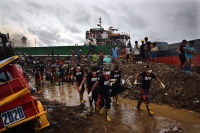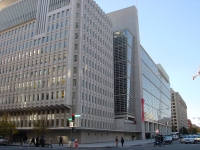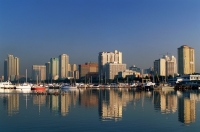Philippines: Amando Tetangco Jr., Governor of the Central Bank (BSP)
2014/01/03
.jpg)
The first upgrade came on March 27 from Fitch, and Standard & Poor’s followed just over a month later, lifting the Philippines out of the junk bond status and placing it among the world’s elite 70 nations deemed suitable for business, where government and the private sector both are capable of paying their obligations. Ultimately, this translates into lower borrowing costs and, of course, higher investor confidence.
Thanks to robust GDP growth, the number of bank loans has increased, while asset quality has improved, says the report.
In early May, after receiving the second upgrade, Finance Secretary Cesar Purisima said, “We are very pleased that S&P, along with Fitch, has also now affirmed the Philippines’ strong economic and fiscal gains.”
“This investment grade rating is another resounding vote of confidence on the Philippines and an affirmation of what the markets already recognize – that our economy’s underlying soundness is on par with countries rated investment grade or higher,” he added.
Governor of Bangko Sentral ng Pilipinas (BSP), the country’s central bank, Amando Tetangco Jr. said the S&P decision “cements the Philippines’ status as an economy with one of the brightest prospects globally.”
S&P cited the country’s fiscal flexibility, healthy forex buffer, resilient remittances and manageable inflation as reasons for the upgrade.
Actual investments over the short to medium term would materialize, he said, and help the country boost foreign direct investment (FDI).“With our investment grade rating, we are more confident that these inflows, particularly of more FDIs, will swing toward increasing the country’s productive capacity, thereby generating more employment and higher incomes,” said Mr. Tetangco.
After enjoying GDP growth of 6.6% in 2012, the government hopes the investment grade will attract funding to the tune of $17 billion for infrastructure development, which in turn would boost growth to as much as 7% in 2013.
The third global credit watcher, Moody’s is yet to upgrade the Philippines to investment grade. Currently, it stands at one notch below (Ba1) with a stable outlook. Nevertheless, Mr. Purisima holds that the market rates the country “at least two notches above investment grade and based on Moody’s own bond implied ratings, we are among the most underrated countries by Moody’s.”
He adds that he is confident Moody’s will soon add a third star to the Philippines’ record, especially since a recent Moody’s Analytics report stated that “the Philippines has been among the brightest parts of a generally gloomy global picture.”
For their part, Philippine banks are also enjoying resilience and the benefits of a growing economy. An S&P report published earlier this year predicted that bank loans would carry on growing at a double-digit rate in 2013, after having grown approximately 10.7% last year.
Aside from their traditional roles in the financial sector, banks in the Philippines also play a key part in maintaining a strong economy, as they are the official entry points for the billions of dollars sent home from overseas Filipino workers (OFWs).
From January to March this year, remittances topped $5.1 billion, up 5.6% over the same period in 2012. Estimates from BSP show that BDO Unibank Inc. leads the banking sector in remittances, capturing 27.8% of the total in 2012. Bank of the Philippine Islands (BPI) came in a close second with 25%, while Philippine National Bank (PNB), Metropolitan Bank & Trust Co. (Metrobank) and Rizal Commercial Banking Corp. (RCBC) accounted for market shares of 15%, 11% and 6%, respectively.
Thanks to the increasing skills levels of Filipino workers, especially in the healthcare sector, salaries are on the rise, as are remittances, which grew 6.3% to $21.39 in 2012. This figure represents around 10% of the country’s entire GDP.
The largest source country by far is the United States, accounting for 42.6% of total remittances, followed by Canada at 8.2%, Saudi Arabia at 7.9%, the U.K. at 5.7% and the UAE, with 4.5%. Gulf countries have of late increased their share, as many of the traditionally stronger economies of the West are still recovering from the economic recession.
- Related Articles

Inflation subdued, employment up
2015/12/27 Strong domestic request and increased government spending helped sustain high levels of economic expansion in the Philippines throughout 2015, though a slight slowdown was observed late in the year as request from the country’s major trading partners eased.
Manufacturing made the biggest contribution to GDP increase
2015/02/14 Despite declining from the highs of 2013, the Philippines’ economy showed marked resilience in 2014, as it battled back from the impact of a devastating typhoon late last year to give a strong in general performance. Economic increase was driven by strong foreign direct investment (FDI), which surpassed government targets well before the end of 2014, alongside remittances and expansion in the real estate, business process outsourcing (BPO) and mining sectors.
The World Bank fails to credit the intelligence of the world’s poor
2015/01/31 At the same time as a statement by the world’s most influential development agency provides evidence that a lot of of its staff are “biased” in their perceptions of the poor and their needs, one may expect eyebrows to be raised. At the same time as the president of that institution — the World Bank, no less — acknowledges the flaw and goes on to call for “measures to mitigate these biases, such as additional rigorously diagnosing the mindsets of the people we are trying to help”, jaws should be dropping.
The Philippines defies external challenges to notch up growth
2013/10/11 Strong domestic request for a broad range of goods and services is galvanising economic increase in the Philippines, helping the country to buck a regional slowdown. Consumer confidence remains high, buoyed by news that the government plans to roll out several large-ticket infrastructure projects, in part aimed at creating jobs. However, the Philippines remains vulnerable to a lot of of the external factors that are weighing on its peers. Consumers show confidence
A Bank Where Social Responsibility is at the Core of its Existence
2013/05/18 The Philippine Veterans Bank (PVB) was prime conceived in 1956, next a reparations agreement, as part of a peace treaty, had been signed with Japan. A portion of the money provided by Japan, which invaded the archipelago in 1941 during World War II, was put into a trust fund for veterans of the war.
- Philippines News
-
- GREECE: Migration and Women’s Health: A Neglected Issue in Need of Action
- JAPAN: Japans emperor visiting the Philippines, a former WWII site
- AFGHANISTAN: Global growth will be disappointing in 2016: IMF's Lagarde
- PHILIPPINES: Two additional years of schooling raises capacity concerns in the Philippines
- PHILIPPINES: Philippines push to list SMEs
- BRUNEI : APEC economies growth slows to 3.1 pct in Q2
- Trending Articles
-
- AUSTRALIA: Australia taxes foreign home buyers as affordability bites
- SERBIA: China’s Xi sees Serbia as milestone on new ‘Silk Road’
- CHINA: United States sees China investment talks ‘productive’ after new offers
- INDIA: Indian central bank chief to step down in surprise move
- THAILAND: Foreign investment plummets in junta ruled Thailand
- UNITED STATES: Trump says Britain should leave EU












